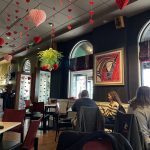Bartok’s “Bluebeard” revisited
"Bluebeard's Castle," with Dale Chihuly's massive glass sculptures, was the MSO hit of 2009. It's back.
A version of this preview story ran at TCD in 2009. I have updated it to apply to the 2013 program.
Bluebeard‘s back, this time with mezzo Michelle DeYoung, bass-baritone Sir John Tomlinson and narrator Dominique Serrand, with de Waart again conducting. Based on the 2009 success, they’ll do it three times, including a Sunday matinee. Glass sculptures by Dale Chihuly, which had a lot to do with the success in 2009, will be back, too.
In the opera, Bluebeard opens six doors for the horrified but undaunted Judith, his fourth wife. In this production, the doors open to reveal fabulous glass sculptures — huge things, 10 feet or taller and 1,500 to 1,800 pounds each. Chihuly, a Seattle resident and great fan of the Seattle Symphony, made them for a semi-staging of the one-act opera for the SSO in 2007.
Anyone who’s ever entered the Milwaukee Art Museum knows Chihuly’s work. You can’t miss the glass extravaganza near the admission desk.
Chihuly took his color cues for the opera from the 1918 libretto, by Bela Balazs after a fairy tale by Charles Perrault, and from the composer. Bartok, envisioning an expressionist/symbolist psychodrama rather than a straightforward narrative, specified stage lighting in specific colors to emanate from each of the first six doors.
He called for a beam of red from the torture chamber behind the first. The second, Bluebeard’s weapons room, emits a flame of yellow and red. The jewels in the third shine in gold light. A blue-green radiance reflects his vast garden, and a blast of white reveals a vista of lands seized by violence. A lake of deep-blue tears behind the sixth door holds the despair of his victims. And the seventh door … well, you can find out when you attend the concert. Color associations extend into the music, too. In the orchestra, the red blood Judith observes on the castle walls, as she coaxes Bluebeard into unlocking seven secret rooms, takes the form of minor seconds.
Balasz and Bartok considered Bluebeard an interior opera, the dream or hallucination of a lonely, ruthless but finally guilt-ridden empire-builder. Judith is a force of love that would bring light to a dark place. But she, too, is seduced to a degree by the fruits of evil. In the end, she takes her place among Bluebeard’s trophies.
Click here to see the Door No. 5 episode from a vintage film version with Georg Solit and the London Philharmonic to get a sense of Bartok’s musical idiom. At this early stage in his career, Bartok’s language was somewhere between the Debussy of Pelleas et Melisande and the R. Strauss of Salome. This is a small opera, with just one act and just two singers. But it is big music, for big voices and a big orchestra.
Laurence Tucker, formerly vice president and chief program officer for the MSO, brought the production to Milwaukee and 2009 and worked for the Seattle Symphony when the Bluebeard project was in progress. Tucker said that it was music director Gerard Schwarz’s idea to get Chihuly involved. Schwarz asked Chihuly to design conventional painted drops, because he knew that Chihuly had been a painter before taking up the glass sculptures that have made him famous.
“Dale wanted to take it a step further,” Tucker said. That resulted in cool sculptures and an enormous shipping problem. The MSO was the first organization outside Seattle to use Chihuly’s pieces.
In Seattle, the singers moved among the sculptures, which were downstage, with the orchestra behind them. In Milwaukee in 2009, the glass rested on a five-foot scaffold behind and above the orchestra. The singers were in their usual downstage positions. Seattle was closer to an opera staging. The MSO did it like a concert performance, and that will be the case again in 2013.
All the sculptures stand in plain sight throughout the MSO version. At the points in the story when doors open, the relevant piece rotates and is bathed in theatrical light designed by Noele Stollmack, the Florentine Opera’s director of design and production.
In contrast to the dark opera, the MSO will open with Mozart’s bright Concerto No. 2 in E-flat major for Horn and Orchestra, K. 417. Matthew Annin, the MSO’s new horn principal, will be the featured soloist.
Research Source: The Grove Book of Operas, Oxford University Press, 2006 edition.
Tickets and Concert Information: Concerts begin at 8 p.m. Friday and Saturday and 2:30 p.m. Sunday, March 15-17, at Marcus Center Uihlein Hall. For tickets, visit the MSO website, call the MSO ticket line, 414 291-7605, or call the Marcus box office, 414 273-7206.




















As a side note, I just played through the Mozart with Rob and Ilana. Both they and that delightful piece are ALSO reasons why this concert should not be missed!
Thanks for the beautiful photos with the piece. Your work with Third Coast is wonderful. Thankfully the arts are getting their voice through this wonderful outlet!
Thanks, Sharon and Stephanie, for reading and for commenting. Every comment raises our profile in search engines and thus helps us build audience. We appreciate it. — Tom
Wow! You really put this weekend’s concerts in perspective. I was trying to figure out how the Chihuly and the music worked together, and as usual, you made it make sense. I really miss you from JS, but am adapting.
the opera was a wonderful experience, with a really good intro (an hour before the concert) to unfamiliar music, but it left me wondering about how such an elaborate — and expensive — scenario could have come into being. your piece really helps, and makes me value the experience even more. who says mke can’t be in the forefront of the arts!